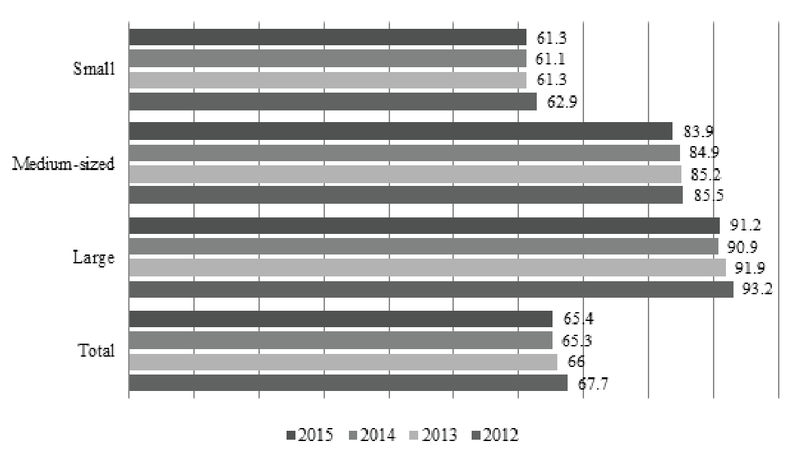Role And Importance Of Fanpage In Promotion Of Products And Services
DOI:
https://doi.org/10.18502/kss.v1i2.658Abstract
The development of information and communication technology significantly determines how enterprises conduct their activities. The use of ICT solutions is visible in each area of the functioning of enterprises, in particular in activities aimed at promotion of products and services. The aim of all promotional activities is to exercise influence on the current and future customers of a company. They involve providing customers with information to increase their knowledge about the products and services and the company itself. In today's digital economic life, in order to reach potential customers and retain the existing ones, companies have to observe and quickly adapt ICT solutions. Key ICT solutions include social media, which have had a significant impact on both the social and economic life. The growing number of social media users contributed to changes in the form and way of communicating and building mutual relations. Moreover, the final say on many issues belongs more and more often to people for whom Internet communication is an integral part of life, which undoubtedly is a clear signal that preferences of today's and future consumers are undergoing a diametrical change. This change in consumers' preferences, expectations and needs forces enterprises to use effective ways of communication and new forms of providing information to a specific target group. Social media users constitute an increasing group that often actively joins promotional activities undertaken by a company. In addition, the social media environment enables presentation of information that is characterised by high quality, elaborate content and interesting form (text, photos, animation or films). These are only some of the factors in favour of the use of social media in the promotional activity of enterprises. However, the modern reality as well as extended functionality and variety of social media are on the one hand conducive to building and maintaining relations with customers, while on the other hand, they requires appropriate preparation of a strategy of action in a new, virtual economic world.
The aim of the paper is to analyse, based on literature studies, the assumptions of enterprises' strategies of action in the social media environment, with particular reference to fanpage. Based on the results of own studies of a group of 172 Polish users of social media conducted at the end of 2015, key actions taken by users on fanpages were indicated, and significant elements influencing the proper structure of fanpage from the user's perspective were presented.
Keywords: Information and communication technology (ICT), social media, fanpage, promotion, products and services
References
R. Agnihotri, R. Dingus, M. Y. Hu, and M. T. Krush, “Social media: Influencing customer satisfaction in B2B sales,” Industrial Marketing Management, vol. 53, pp. 172–180, 2016.
D. Buchnowska, “Analiza i ocena poziomu wykorzystania mediów społecznościowych przez największe polskie przedsiębiorstwa,” Informatyka Ekonomiczna (Business Informatics), vol. 4, no. 30, pp. 55–69, 2013.
S. Greengards, “How to win with social media,” Baseline, pp. 16–21, 2011.
K. D. Hyun and J. Kim, “Differential and interactive influences on political participation by different types of news activities and political conversation through social media,” Computers in Human Behavior, vol. 45, pp. 328–334, 2015.
A. M. Kaplan and M. Haenlein, “Users of the world, united! The challenges and opportunities of social media,” Business Horizons, vol. 53, no. 1, pp. 59–68, 2010.
M. Kowalska, “Funkcjonalność mediów społecznościowych jako siedem boków plastra miodu,” Acta Universitatis Nicolai Copernici Zarządzanie, no. Nauki humanistyczno-społeczne — No 413, pp. 205–215, 2015.
A. Lemańska-Majdzik, and M. Okręglicka, “Determinants and areas of an organisation’s success - literature review,” in Proceedings of International Academic Conference on Management, Economics and Marketing in Vienna 2015 (IAC-MEM 2015 in Vienna), pp. 32–42, Vienna, Austria, 2015.
E. W. T. Ngai, S. S. C. Tao, and K. K. L. Moon, “Social media research: Theories, constructs, and conceptual frameworks,” International Journal of Information Management, vol. 35, no. 1, pp. 33–44, 2015.
M. Okręglicka, “Zastosowanie technologii informacyjno-komunikacyjnych w malych i srednich przedsiebiorstwach a budowanie przewagi konkurencyjnej,” in Zarzadzaniepodmiotami gospodarczymi w turbulentnym otoczeniu. Aspekty teoretyczne i praktyczne, Sekcja Wydawnictw Wydzialu Zarzadzania Politechniki Czestochowskiej, K. Wolniakowska, Ed., pp. 33–43, Czestochowa, 2013.
F. Parveen, N. I. Jaafar, and S. Ainin, “Social media usage and organizational performance: Reflections of Malaysian social media managers,” Telematics and Informatics, vol. 32, no. 1, pp. 67–78, 2014.
J. V. Pavlik, “Mapping the Consequences of Technology on Public Relations. Retrieved from,” Telematics and Informatics, vol. 15, pp. 176–186, 2007, http://www.instituteforpr.org/files/uploads/Pavlik_Mapping_Consequences.pdf.
K. Polańska, “Business models and social media in the electronic economy,” Information Systems in Management, vol. 1, no. 3, pp. 223–232, 2012.
M. Rzemieniak, “Social media w kontekscie rozwoju spoleczenstwa informacyjnego,” Zeszyty Naukowe Uniwersytetu Szczecinskiego.Ekonomiczne Problemy Usług No, vol. 650, pp. 624–630, 2011.
R. Štefko, R. Bačík, and I. Fedorko, “Facebook content analysis of banks operating on Slovak market,” Polish Journal of Management Studies, vol. 10, no. 1, pp. 145–152, 2014.
J. Sasak and P. Pypłacz, “Współczesne narzędzia zarządzania relacjami uczelni wyższych ze studentami,” in Wyzwania współczesnego zarządzania. Tendencje w zachowaniach organizacyjnych, L. Kiełtyka, W. Jędrzejczyk, and P. Kobis, Eds., p. 79, Dom Organizatora, Toruń, 2015.
K. Smoląg and B. Ślusarczyk, “The Role of Social Media in Creation of Relational Capital In Universities,” in Proceedings of 6th International Conference on Management, Finance & Entrepreneurship (ICMFE-2015), pp. 90–94, Istanbul, Turkey, 2015.
K. Sumara, et al., 2013. Polskie firmy w mediach społecznościowych, Capgemini [online], [cit.: 10.03.2016]. Available: http://www.ican.pl/files/PDF/raport_992.pdf.
P. Tomski, “Paradygmat hiperdynamiki otoczenia a współdziałanie gospodarcze współczesnych przedsiębiorstw,” Zeszyty Naukowe Politechniki Częstochowskiej, vol. 1, pp. 7–18, 2011.
A. Wisniewska-Salek and Kulej-Dudek E., “Innovative activity and information technology in the context of developing rural economy,” in Transformation Management of Economic at Rural Areas, A. Brzozowska and A. V. Kalinichenko, Eds., p. 193, Poltava State Agrarian Academy, Poltava, 2015.
B. Ziółkowska, Zarządzanie procesami tworzenia wartości w przedsiębiorstwie. Perspektywa wirtualizacji, Wydawnictwo Politechniki Częstochowskiej, Częstochowa, 2013.
http://networkeddigital.com/2010/05/10/podzial-i-klasyfikacja-social-media/, [cit.: 10.03.2016].
http://www.cbos.pl/SPISKOM.POL/2014/K_082_14.pdf, [cit.: 10.03.2016], pp.14-15.
https://www.eactive.pl/aktualnosci/czy-popularnosc-serwisowspolecznosciowych- ciagle-wzrasta/.
http://www.pewinternet.org/2015/01/09/social-media-update-2014/, [cit.: 10.03. 2016].
http://stat.gov.pl/obszary-tematyczne/nauka-i-technika-spoleczenstwoinformacyjne/ spoleczenstwo-informacyjne/spoleczenstwo-informacyjne-wpolsce- w-2015-r-,2,5.html, [cit.: 10.03.2016].
http://www.sotrender.pl/trends/facebook?hp&_ga=1.65845804.341348613. 1458296589, [cit.: 10.03.2016].
http://ec.europa.eu/eurostat/data/database, [cit.: 10.03.2016].

